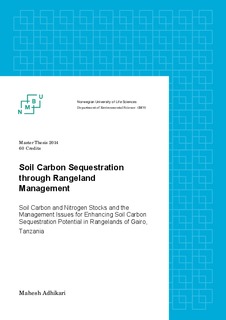| dc.contributor.author | Adhikari, Mahesh | |
| dc.date.accessioned | 2014-09-22T11:41:21Z | |
| dc.date.available | 2014-09-22T11:41:21Z | |
| dc.date.copyright | 2014 | |
| dc.date.issued | 2014-09-22 | |
| dc.identifier.uri | http://hdl.handle.net/11250/220873 | |
| dc.description.abstract | Rangelands are the unutilized lands which constitute 47% of the world land area containing very low SOC. Though they have very low tendency to store carbon, it can be enhanced by few management practices as these holds considerably large area. The study was conducted in soils of two villages of Gairo district, Tanzania, where Leshata was degraded and Mkalama was highly degraded. They showed very low concentration of SOC (<1%). The nutrients like N, P, and K were found to be very low in both of the villages though the concentration of them was found greater in Mkalama in comparison to Leshata. The soil texture based on USDA system of classification showed that the soil in Leshata was a sandy clay loam, whereas in Mkalama it was sandy clay. The bulk density was found to be 1.51 g/cm3 and 1.37 g/cm3 in Leshata and Mkalama respectively, while corresponding values for pH were 5.13 and 5.36. High density and low pH as the characteristics of degraded soil is shown in both villages. Carbon showed strong correlation with nitrogen in both of the villages (r=0.87, P=0.00) in Leshata and (r=0.75, P=0.00) in Mkalama. Leshata showed decrease in concentration of carbon and nitrogen with the increase in depth, whereas Mkalama did not show any proper depth wise distribution. Water is the limiting factor in context to both of the villages as the loss of water occurs through surface runoff due to lower infiltration in Mkalama, whereas lower water retention capacity due to bigger pores in Leshata. The C: N ratio in these two villages is greater than (10:1) making them useful in storing carbon from future perspectives. But the compact nature of soil with sloppy landscape in Mkalama is prone to erosion during rainfall leading to soil degradation as it erodes away the valuable nutrients required for the growth of plants. So, management practises like developing contours, plantation of Xerophytic plants, control livestock and liming with calcite for regulating soil pH in these acidic soils might be helpful in preventing erosion and restoring carbon. These practices not only help to prevent soil degradation, but also restore soil carbon stock leading to enhanced soil carbon sequestration potential. | nb_NO |
| dc.description.sponsorship | NORAGRIC (NMBU), CCAIM Project | nb_NO |
| dc.language.iso | eng | nb_NO |
| dc.publisher | Norwegian University of Life Sciences, Ås | |
| dc.rights | CC0 1.0 Universal | * |
| dc.rights.uri | http://creativecommons.org/publicdomain/zero/1.0/ | * |
| dc.title | Soil carbon sequestration through rangeland management : soil carbon and nitrogen stocks and the management issues for enhancing soil carbon sequestration potential in rangelands of Gairo, Tanzania | nb_NO |
| dc.type | Master thesis | nb_NO |
| dc.subject.nsi | VDP::Agriculture and fishery disciplines: 900::Agriculture disciplines: 910::Soil sciences: 913 | nb_NO |
| dc.subject.nsi | VDP::Agriculture and fishery disciplines: 900::Agriculture disciplines: 910::Management of natural resources: 914 | nb_NO |
| dc.subject.nsi | VDP::Mathematics and natural science: 400::Chemistry: 440::Environmental chemistry, natural environmental chemistry: 446 | nb_NO |
| dc.source.pagenumber | 77 | nb_NO |
| dc.description.localcode | M-PV | nb_NO |

